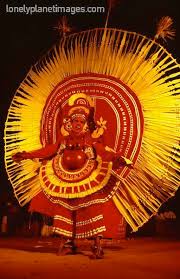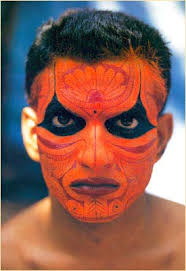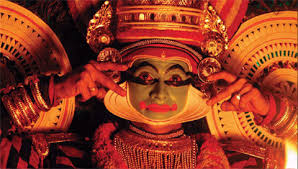Drama in itself is a complete form of arts. It includes in its framework acting, dialogue, poetry, music, singing etc. Traditional theatre-forms are an expression of the feelings of the community. They are presented on various occasions such as festivals, fairs, ritual offerings, gatherings etc throughout the year. Some generic features of traditional theatre-forms are given at the end of the article.
Now I shall present notes on the various traditional theatre-forms of India.[Q on this was asked in 2011 Mains].
Bhand Pather
- traditional theatre form of Kashmir
- a unique combination of dance, music and acting.
- Biting satire, wit and parody characterize the form.
- music is provided with surnai, nagaara and dhol.
- The actors of Bhand Pather are mainly from the farming community and the impact of their way of living, ideals and sensitivity in the drama is discernible.
- Sometimes masks are also used in the performance.
Swang
- from Haryana and Western UP.
- Musical folk-drama evolved in 18th century.
- Has stories in verse sung in various mode (classical, semi-classsical, folk). However gradually prose has been included in it too enacted as dialogues.
- The softness of emotions, accomplishment of rasa alongwith the development of character can be seen in this theatre form.
- Two important styles of Swang are from Rohtak and Haathras. In the style belonging to Rohtak, the language used is Haryanvi (Bangru) and in Haathras, it is Brajbhasha.
- Initially cast was all male but women have started participating.
- Swang means impersonation. The Nautanki of UP, Khyal of Rajasthan are in this tradition.
- Tradition of Punjab, which continues the Swang tradition.
- Naqal translates as mimicry or imitation and the naqalchi is the mimic. The form being farcical in nature, it relies heavily on improvisation by the naqalchi.
- Centuries-old village tradition, very popular at weddings
- Solo performance of group of 2-3 dressed in rustic clothes
- Perform a series of skits, in a small space, each lasting 10 mins or so. Made up of quick repartee, gentle satire,
- Subject-matter is purely social, like hilarious situations from the everyday. This form is purely secular.
- For more on Naqal read: www.global.ucsb.edu/punjab/journal/v18_1_2/.../7_Naqqals.pdf
Nautanki
Tamaasha



Koodiyaattam / Kutiyattam


PANDAVANI
Nachya
Burrakatha Harikatha
GENERIC FEATURES of TRADITIONAL THEATRE-FORMS
- usually associated with Uttar Pradesh.
- Important centres are Kanpur, Lucknow and Haathras.
- The meters used in the verses are: Doha, Chaubola, Chhappai, Behar-e-tabeel.
- Initially only men acted in Nautanki but nowadays, women have also started taking part in the performances.
- Among those remembered with reverence is Gulab Bai of Kanpur.
Bhagat
- UP, mainly Agra and Mathura
- Considered to be parent form of Nautanki is 400 yrs old
- Initially consisted of dramatized devotionaal singing by devotees of the Vaishnava sect. Later tales of romance, valour and kings added
- Religious rituals at the beginning and end provide a frame for the performance. At the beginning an actor playing Ganesh dances on the stage, who is then worshipped by the other actors.
- Language of the bhagat is a mix of Hindi, Urdu, Braj.
Rasleela
- UP
- based exclusively on legends of Lord Krishna
- believed that Nand Das wrote the initial plays based on the life of Krishna.
- the dialogues in prose combined beautifully with songs and scenes from Krishna's pranks.
Bhavai
- traditional theatre form of Gujarat.
- traditionally performed during Navratri before the shrine of Amba Mata or before a lamp symbolizing the deity.
- Important centres are Kutch and Kathiawar.
- Instruments used in Bhavai are: bhungal, tabla, flute, pakhaawaj, rabaab, sarangi, manjeera, etc.
- In Bhavai, there is a rare synthesis of devotional and romantic sentiments.
Jatra
- Born and nurtured in Bengal
- Performed at fairs in honour of gods, or religious rituals and ceremonies
- Krishna Jatra became popular due to Chaitanya's influence. Later, however, worldly love stories too, found a place in Jatra.
- The earlier form of Jatra has been musical. Dialogues were added at later stage.
- The actors themselves describe the change of scene, the place of action, etc.
Maach
- Madhya Pradesh.
- The term Maach is used for the stage itself as also for the play.
- In this theatre form songs are given prominence in between the dialogues.
- Dialogues are called bol and rhyme in narration is termed vanag.
- Tunes of this theatre form are known as rangat.
- Assam, but cultural glimpses of Assam, Bengal Orissa, Mathura and Brindavan can be seen.
- Bhaona is a presentation of Ankia Naat.
- The Sutradhaar, or narrator begins the story, first in Sanskrit and then in either Brajboli or Assamese.
- Ankiya naat are one-act plays interspersed with Sanskrit verses. They were composed for common people in simple language. A close link with Sanskrit theater can be seen.
Tamaasha
- Maharashtra.
- It has evolved from the folk forms such as Gondhal, Jagran and Kirtan.
- The female actress is the chief exponent of dance movements in the play, (unlike other theatre-forms). She is known as Murki.
- Classical music, footwork at lightning-speed, and vivid gestures make it possible to portray all the emotions through dance.
Dashavatar
- Konkan and Goa regions.
- The performers personify the ten incarnations of Lord Vishnu-the god of preservation and creativity. The ten incarnations are Matsya (fish), Kurma (tortoise), Varaha (boar), Narsimha (lion-man), Vaman (dwarf), Parashuram, Rama, Krishna (or Balram), Buddha and Kalki.
- Apart from stylized make-up, the Dashavatar performers wear masks of wood and papier mache.
Krishnattam,
- Kerala- came into existence in the mid17th century A.D. in Calicut.
- Krishnattam is dance-drama presenting the story of Krishna in a cycle of eight plays performed for eight consecutive days. The plays are Avataram, Kaliamandana, Rasa krida, kamasavadha, Swayamvaram, Bana Yudham, Vivida Vadham, and Swargarohana.
Mudiyettu,
- Kerala
- Celebrated in the month of Vrischikam (November-December).
- Usually performed only in the Kali temples of Kerala, as an oblation to the Goddess.
- It depicts the triumph of goddess Bhadrakali over the asura Darika.
- The seven characters in Mudiyettu-Shiva, Narada, Darika, Danavendra, Bhadrakali, Kooli and Koimbidar (Nandikeshvara) are all heavily made-up.
- In 2010, Mudiyettu was included in the UNESCO Intagible Cultural Heritage List.
Theyyam
- Kerala.
- word 'Theyyam' is derived from 'Daivam' meaning God. Hence it is called God's dance.
- Theyyam is performed by various castes to appease and worship spirits of ancestors, folk-heores, deities of diseases etc.
- Distinguishing features is the colourful costume and awe-inspiring headgears (mudi) nearly 5 to 6 feet high made of arecanut splices, bamboos, leaf sheaths of arecanut and wooden planks and dyed into different strong colours using turmeric, wax and arac.
- Face is always painted in an orange base-colour.
Koodiyaattam / Kutiyattam
- Kerala
- based on Sanskrit theatre traditions.
- Characters of this theatre form are: Chakyaar (actor), Naambiyaar (instrumentalists) and Naangyaar (those taking on women's roles). The Sutradhar (narrator) and the Vidushak (jesters) are the protagonists.
- Vidushak alone delivers the dialogues.
- Emphasis on hand gestures and eye movements makes this dance and theatre form unique.
- Koodiyaattam was included in the UNESCO Intagible Cultural Heritage List as a Masterpieces of the Oral and Intangible Heritage of Humanity
- Karnataka
- Based on mythological stories and Puranas- most popular episodes are from the Mahabharata i.e. Draupadi swayamvar, Subhadra vivah, Abhimanyu vadh, Karna-Arjun yuddh and from Ramayana i.e. Raajyaabhishek, Lav-kush Yuddh, Baali-Sugreeva yuddha and Panchavati.
Therukoothu
- Tamil Nadu
- Literally means "street play". It is mostly performed at the time of annual temple festivals of Mariamman (Rain goddess) to achieve rich harvest.
- There is a cycle of eight plays based on the life of Draupadi.
RAMMAN
- Uttarakhand
- Combining theatre, music, historical reconstructions, and traditional oral and written tales, the Ramman is a multiform cultural event
- It is celebrated every year in Baisakh month (april) in the courtyard of the temple of Bhumiyal Devta situated in Chamoli district, Uttarakhand.
- Mask dance performed exclusively by the Bhandaris (Ksatriya caste).
- Included in the UNESCO Representative list of Intangible Cultural Heritage of Humanity.
PANDAVANI
- This form of folk theatre is popular in the Indian state of Chhattisgarh and in the neighbouring tribal areas of Orissa and Andhra Pradesh.
- Musical narration of tales from the Mahabharata with one lead narrator-singer, enacting and singing with an ektara
- No use of stage props or settings, it mainly relies on mimicry and rousing theatrical movements. Sometimes the singer-narrator breaks into an impromptu dance, at the completion of an episode or to celebrate a victory with the story being retold.During a performance, as the story builds, the tambura becomes a prop, sometimes it becomes to personify a gada, mace of Arjun, or at times his bow or a chariot, while others it becomes the hair of queen Draupadi or Dushshasan thus helping the narrator-singer play all the characters of story.
- Teejan Bai is most renowned singer to this style
- Traditional musical-theatre form from Rajasthan.
- Derived from khel (play), khyal probably took shape as a musical dance-drama in the early eighteenth century.
- Based on mythological, historical, or popular romantic tales, emphasizing qualities of heroism, self-sacrifice, and nobility.
- Types of khyal are identified by the kind of stage used or the musical variations selected. In the Turra Kilangi khyal is performed on an elaborately decorated stage, while the Kuchamani khyal is simpler in presentation but has specific music and dance steps.
- Highly improvisatory in nature, with loosely structured plots and witty dialogue, khayal requires an intimate audience–actor relationship.
- Its primary attraction is its soulful singing, accompanied by the nakkara and dholak (both percussion), sarangi (bowed instrument), and sometimes shehnai (wind instrument).
- Prompters with a copy of the dramatic text are always on the stage. This is a convention that Khyal shares with Maach of MP where they are known as pustakji.
- [Note: Not to be confused with 'Khayal' - a type of hindustani classsical vocal rendition].
Nachya
- Chhattisgarh, Vidarbha
- Influenced by Ganda musicians and entertainment form Gammat
- Select a situations from life of agricultural community and improvise. No written text is followed.
- Treatment is humourous and satirical
- Play begins with invocation of Ganesh and Saraswati.
- In one form of nachya, the Jokkad Pari, the performers dance with flaming torches.
- presented during the religious festivals in praise of 'Bhagavan'. Thus the performances were called 'Bhagavathams'.
- Veedhi in Telugu means street; an open place. So Veedhi Natakam is any dramatic performance presented in a street.
Burrakatha
- a storytelling technique used in villages of Andhra Pradesh, Karnataka and Tamil Nadu.
- The troupe consists of one main performer and two co-performers.
- It is a narrative entertainment that consists of prayers, solo drama, dance, songs, poems and jokes.
- The topic will be either a Hindu mythological story or a contemporary social problem.
- Harikatha, also known as Katha Kalakshepa, is a variant which narrates tales of Lord Krishna, other Gods and saints.
Burrakatha Harikatha
GENERIC FEATURES of TRADITIONAL THEATRE-FORMS
- In all the traditional theatre-forms, songs and the art of singing have an important role to play.
- There is a classical element in these theatre forms too, which takes on regional, local and folk coloring.
- In traditional theatre forms there are certain conventions of presentations depending upon and changing according to the form and size of the stage or the platform and other available situations.
- In traditional theatre forms, there is no such thing as episodes. There is always continuity in its theme, structure and presentation.
- There is direct and intimate communication between the actors and the audience.
- In traditional theatre forms, characters keep changing their place on the stage to be more impressive and to give the situation a greater significance. This technique also reduces the chance of boredom through repetition and stillness.
- Dialogue delivery is usually carried out in a high pitch. This helps the actors in reaching out to a larger audience. The artists always add something or the other to the original dialogue on their own. The changes brought through improvisations, make the spectators ecstatic and help in building a rapport with the audience.
Source:
http://news.bbc.co.uk/2/shared/spl/hi/pop_ups/05/south_asia_india0s_changing_folk_theatre/html/1.stm
ignca.nic.in/ICH/ich_detail/ich00022.pdf
World Encyclopedia of Contemporary Theatre: Aisa. books.google.co.in/books?isbn=041505933X...
McGraw Hill Encyclopadeia of World Drama: books.google.co.in/books?isbn=0070791694...
No comments:
Post a Comment